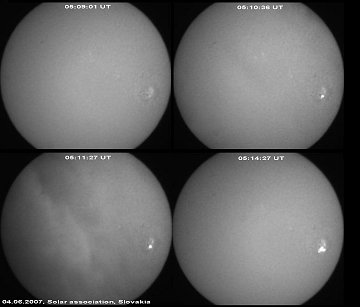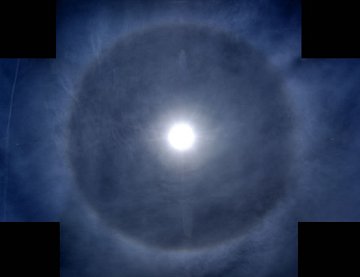 Would you like to hear about solar flares--while they're flaring? Get instant alerts from SpaceWeather PHONE. Would you like to hear about solar flares--while they're flaring? Get instant alerts from SpaceWeather PHONE. AURORA WATCH: A solar wind stream is buffeting Earth's magnetic field and causing mild geomagnetic storms. High-latitude sky watchers should be alert for auroras. ACTIVE SUNSPOT: This morning in Slovakia, Kristian Molnar had just attached a digital camera to his Personal Solar Telescope when a ball of light bloomed over sunspot 960: 
"I was lucky to be observing the sun at the right moment," says Molnar. "The weather was cloudy, but the activity is still nicely visible." The eruption he saw was an M9-class solar flare peaking at 0513 UT on June 4th. Even stronger flares are possible from this behemoth sunspot. NOAA forecasters estimate a 20% chance of X-flares during the next 24 hours. Stay tuned! more images: from Dennis Simmons of Brisbane, Qld, Australia;
from Robert Arnold of Isle of Skye, Scotland; from Pavol Rapavy of Rimavska Sobota,Slovakia; from Pete Lawrence of Selsey, UK; from artist Mark Seibold of Troutdale, Oregon; from Alan Friedman of Buffalo, New York. HEAVENLY HALO: "It's not just the surface of the sun that's active today," reports Andrew Greenwood of Kerridge, England. The sky around the sun is pretty lively, too: 
Photo details: Nikon D50, f22, 200 ISO, 1/1250
"This has to be the most wonderful ice halo display I have ever seen," says Greenwood. "I couldn't stop taking pictures: #1, #2, #3, #4." Ice halos are rings around the sun caused by ice crystals floating in high clouds. They're visible even on hot days, because clouds 5 to 10 km high, where these halos form, are freezing cold even at the peak of summer. Put your hand in front of the sun and look around, you might catch one! more images: from Stephane Levesque of Ste Luce, Quebec; from Riccardo Di Nasso of Italy; from Dave Hancox of Dalmellington, Scotland; from Ralph Nevins of Ottawa Ontario; from James Willinghan of Elkridge, Maryland; from Branislav Bezdeda of Nova Dubnica, Slovakia; from Jefferson Teng of Lampung, Indonesia; from Bill Weir of Metchosin (Victoria) British Columbia, Canada; from Mila Zinkova of San Francisco, California. | 
